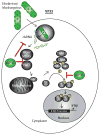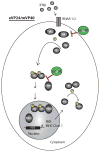Innate immune evasion by filoviruses
- PMID: 25843618
- PMCID: PMC4424075
- DOI: 10.1016/j.virol.2015.03.030
Innate immune evasion by filoviruses
Abstract
Ebola viruses and Marburg viruses, members of the filovirus family, cause severe hemorrhagic fever. The ability of these viruses to potently counteract host innate immune responses is thought to be an important component of viral pathogenesis. Several mechanisms of filoviral innate immune evasion have been defined and are reviewed here. These mechanisms include suppression of type I interferon (IFN) production; inhibition of IFN-signaling and mechanisms that either prevent cell stress responses or allow the virus to replicate in the face of such responses. A greater understanding of these innate immune evasion mechanisms may suggest novel therapeutic approaches for these deadly pathogens.
Keywords: Ebola virus; Hemorrhagic fever; Innate immunity; Interferon; Marburg virus.
Copyright © 2015 Elsevier Inc. All rights reserved.
Figures



References
-
- Ebola Situation Report. World Health Organization; Jan 21, 2015.
-
- Amman BR, Carroll SA, Reed ZD, Sealy TK, Balinandi S, Swanepoel R, Kemp A, Erickson BR, Comer JA, Campbell S, Cannon DL, Khristova ML, Atimnedi P, Paddock CD, Crockett RJ, Flietstra TD, Warfield KL, Unfer R, Katongole-Mbidde E, Downing R, Tappero JW, Zaki SR, Rollin PE, Ksiazek TG, Nichol ST, Towner JS. Seasonal pulses of Marburg virus circulation in juvenile Rousettus aegyptiacus bats coincide with periods of increased risk of human infection. PLoS Pathog. 2012;8:e1002877. - PMC - PubMed
-
- Baize S, Pannetier D, Oestereich L, Rieger T, Koivogui L, Magassouba N, Soropogui B, Sow MS, Keita S, De Clerck H, Tiffany A, Dominguez G, Loua M, Traore A, Kolie M, Malano ER, Heleze E, Bocquin A, Mely S, Raoul H, Caro V, Cadar D, Gabriel M, Pahlmann M, Tappe D, Schmidt-Chanasit J, Impouma B, Diallo AK, Formenty P, Van Herp M, Gunther S. Emergence of Zaire Ebola Virus Disease in Guinea - Preliminary Report. N Engl J Med 2014 - PubMed
Publication types
MeSH terms
Substances
Grants and funding
LinkOut - more resources
Full Text Sources
Other Literature Sources
Medical

